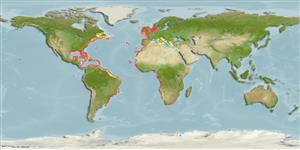Actinopterygii (ray-finned fishes) >
Tetraodontiformes (Puffers and filefishes) >
Balistidae (Triggerfishes)
Etymology: Balistes: Latin, balista, -ae = crossbowman. In Greek, ballo = to throw (Ref. 45335). More on author: Gmelin.
Environment / Climate / Range
Ecology
Marine; reef-associated; depth range 0 - 100 m (Ref. 7348), usually 0 - 55 m (Ref. 55172). Subtropical, preferred 24°C (Ref. 107945); 58°N - 37°S, 98°W - 36°E
Eastern Atlantic: Mediterranean to Moçamedes, Angola. Western Atlantic: Nova Scotia (Canada), Bermuda, and northern Gulf of Mexico to Argentina (Ref. 7251).
Length at first maturity / Size / Weight / Age
Maturity: Lm 16.3, range 13 - ? cm
Max length : 60.0 cm TL male/unsexed; (Ref. 7348); common length : 44.0 cm TL male/unsexed; (Ref. 47377); max. published weight: 6.2 kg (Ref. 40637)
Dorsal
spines
(total): 3;
Dorsal
soft rays
(total): 26-29;
Anal
spines: 0;
Anal
soft rays: 23 - 26. Tall, with a small mouth and plate like scales (Ref. 35388). Three faint irregular broad dark bars on body; a narrow pale transverse band on chin; small light blue spots on upper half of body and median fins, and irregular short lines ventrally (Ref. 13442).
Inhabits bays, harbors, lagoons, and seaward reefs (Ref. 9710). May drift with young at surface among Sargassum (Ref. 9710). Usually solitary or in small groups (Ref. 9710). Feeds on benthic invertebrates like mollusks and crustaceans (Ref. 4727). Oviparous (Ref. 205). Consumed mostly fresh, smoked, and dried salted. The flesh is of excellent quality. Because it is resistant to capture, it proliferates and competes for food with other species (Ref. 5377).
Smith-Vaniz, W.F., B.B. Collette and B.E. Luckhurst, 1999. Fishes of Bermuda: history, zoogeography, annotated checklist, and identification keys. American Society of Ichthyologists and Herpetologists Special Publication No. 4. 424 p. (Ref. 35505)
IUCN Red List Status (Ref. 115185)
CITES (Ref. 94142)
Not Evaluated
Threat to humans
Reports of ciguatera poisoning (Ref. 30911)
Human uses
Fisheries: commercial; gamefish: yes; aquarium: public aquariums
Tools
Special reports
Download XML
Internet sources
Estimates of some properties based on models
Phylogenetic diversity index (Ref.
82805): PD
50 = 0.5078 [Uniqueness, from 0.5 = low to 2.0 = high].
Bayesian length-weight: a=0.02042 (0.01723 - 0.02419), b=2.90 (2.85 - 2.95), in cm Total Length, based on LWR estimates for this species (Ref.
93245).
Trophic Level (Ref.
69278): 4.1 ±0.2 se; Based on diet studies.
Resilience (Ref.
69278): Medium, minimum population doubling time 1.4 - 4.4 years (K=0.18-0.43; tm=1).
Vulnerability (Ref.
59153): Moderate to high vulnerability (49 of 100) .
